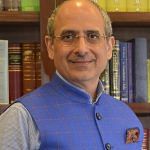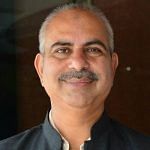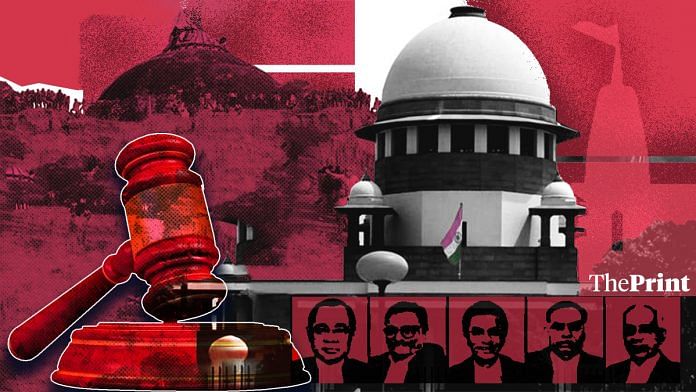The Supreme Court’s five-judge bench led by CJI Ranjan Gogoi Saturday delivered a unanimous verdict on the Ram Janmabhoomi-Babri Masjid case giving the disputed site in Ayodhya to Hindus, ordering the government to set up a trust in three months to build Ram Mandir and allot five acres of land to the Sunni Waqf Board to build a mosque.
ThePrint asks: Can the Supreme Court’s Ayodhya verdict bring closure?
SC’s verdict should not be seen as victory or defeat for any faction

Nalin Kohli
National Spokesperson, BJP
The Supreme Court has delivered a historic, unanimous and inclusive judgment. It has brought closure to a long-standing dispute, which had gone through many rounds of litigation over several decades.
The Supreme Court must also be commended for the effort it undertook in patiently hearing, on a day-to-day basis, the arguments of the various parties involved in the Ayodhya case. This judgment will further increase the faith of 130 crore Indians in the judiciary and process before the courts.
Prime Minister Narendra Modi has called upon everyone not to see the Ayodhya case verdict through the narrow prism of victory or defeat. The very fact that leaders across the political spectrum, led by PM Modi himself, are welcoming the judgment and calling upon everyone to maintain peace and harmony needs to be appreciated. People themselves have heeded this call and sent a positive message about the strength of India’s unity in diversity and democratic traditions.
The judgment certainly brings about closure to a long-pending issue.
Case of Ram Mandir is a classic tale of Hindus’ patience and persistence
 Arun Anand
Arun Anand
CEO of Indraprastha Vishwa Samvad Kendra, & author of The Saffron Surge: Untold Story of RSS
The nation had been waiting patiently for the Supreme Court’s decision on the Ayodhya dispute case since 2011. Had the Congress government constructed the Ram Mandir in Ayodhya immediately after India’s independence just as it had done in the case of Somnath temple in Gujarat, the Ram Janmabhoomi-Babri Masjid issue wouldn’t have simmered for so long.
The Hindus had started their struggle to reclaim the ‘birthplace’ of Lord Ram immediately after 1528 when the Babri Masjid was built. They fought around 76 battles and sacrificed many lives to reclaim the land where a temple had existed before it was destroyed by Babar, the invader. The Hindus never stopped worshipping Lord Ram there even after the temple was destroyed while the Muslims didn’t offer any prayers there for the next 300 years.
The case of Ram Mandir is a classic tale of Hindus’ patience and persistence. With the Supreme Court taking a final call on the issue Saturday and decreeing that the disputed land should be allotted to the deity, the matter should now have a final closure.
However, there are indications that one of the aggrieved parties may file a review petition. That could delay the closure. However, it would be better if everyone accepts the judgement and joins hands to build a Ram temple in Ayodhya as Lord Ram’s legacy shouldn’t be tied up with any community or any particular way of worshipping.
Also read: Why liberals won’t be looking forward to DY Chandrachud’s term as CJI after Ayodhya verdict
There should be efforts to reclaim lost idea of secular India so that Kashi and Mathura claims are not made
 Purushottam Agarwal
Purushottam Agarwal
Professor and author
The Ram Janmabhoomi-Babri Masjid case has gone on for long. It is time for it to end. While the legal aspect of the issue remains with hints of a review petition, one can’t ignore the political realities around Ayodhya. They are the result of the mishandling of the situation by successive governments after the Babri Masjid was demolished in 1992.
If you are aggrieved with the judgement, the best you can do is file a review petition in the court. However, there should be an attempt to, at the ground level, reclaim the lost idea of a secular India to ensure that similar claims of Kashi and Mathura are not made in the future.
There is no point in dragging the Ayodhya case by filing a review petition. I believe giving Muslims another plot to build a mosque is enough.
In 2010, the Allahabad High Court had attempted to put an end to this decades-long dispute by ordering the trifurcation of the land among the three parties involved. That judgement should’ve been accepted by all factions back then itself.
At the end of the day, it is not a question of legality, but of political realities.
All the evidence was in our favour. On what basis are we being debarred from the place?
 Syed Qasim Rasool Ilyas
Syed Qasim Rasool Ilyas
President, Welfare Party of India
The Supreme Court has definitely let the Sunni Waqf Board down because of its contradictory observations in the Ayodhya case verdict.
On the one hand, it said that the Nirmohi Akhara doesn’t have any right to the land and the idols were illegally kept inside the mosque in 1949. On the other hand, it also remarked that the Sunni Waqf Board hasn’t established its right of possession.
The Sunni Waqf Board never asked for an alternate land to build a mosque on. Our claim had always been that this site belongs to us.
The Supreme Court always maintained that it won’t decide the Ayodhya case outcome on the basis of faith but on archeological facts. However, the verdict announced Saturday is one based on faith. Ram Janmabhoomi Nyas didn’t come out with any substantial proof of their right to the land.
The problem is that all the evidence was in our favour, so on what basis are we being debarred from the place? How could the Supreme Court allot that site to a party that wasn’t even there in the picture until 1989?
We reject the five-acre land allotted to us, we never demanded that.
Also read: Govt trust to get disputed Ayodhya site for Ram Mandir, Muslims to get another plot: SC
Dominant view in Muslim community is that an adverse ruling is better than out-of-court compromise
 Rasheed Kidwai
Rasheed Kidwai
ORF visiting fellow and author of Sonia, a Biography and 24 Akbar Road
For many in the majority community, the Supreme Court’s Ayodhya verdict is a triumph of faith and reaffirms their belief that Lord Ram was born at the disputed site. While a section of Muslims considers the Supreme Court’s unanimous verdict to be a bit unfavourable, the dominant view within the community is that an adverse ruling is better than any out-of-court compromise.
Overall, the verdict does bring a sense of closure.
Politically, however, it is unlikely that the construction of Ram temple in Ayodhya alone would ensure the return of Yogi Adityanath’s regime in Uttar Pradesh.
An out-of-court settlement had the potential to embolden the opposing side to launch similar agitations against other mosques in India. The fears of Muslim scholars are not without a reason. In 1990, Arun Shourie, journalist-turned-BJP-minister-turned-Modi-critic, and Hindu revivalists Sitaram Goel, Ram Swarup, Jay Dubashi and Harsh Narain, had published a list of 3,000 mosques that they claimed were actually temples, in a two-volume tract titled ‘Hindu Temples: What Happened to Them’.
The current mood in the Muslim community is one of conciliation and acceptance.
Supreme Court’s unanimous verdict corrected a civilisational wrong, brings permanent healing of ‘wounds’
 Sudarshan Ramabadran
Sudarshan Ramabadran
Senior Research Fellow, India Foundation
Ayodhya by itself means ‘no conflict’. History is evidence to the fact that it has remained a civilisational issue and a matter of faith for millions. In my view, the unanimous judgement by the Supreme Court has corrected a civilisational wrong and is in no way against any religion or community.
Importantly, this judgement also gives credence to the fact that when there are scientific arguments or presentations of historical facts made, as was discernible in the recent 40-day hearing of the Ayodhya case, it will then unanimously lead to a decisive verdict. It is also in a way the permanent healing of ‘wounds’ of our civilisation by asking the Centre to allot 5 acres of land to Muslims.
This is a much needed, remarkable gesture, something which the central governments in the past have been advised to bring. This will also pave the way for the government to ensure equality and justice for all, not to mention peace and closure.
It has brought relief to both the Hindu and the Muslim communities and the time has come for us to celebrate diversity in unity.
Without justice for demolition and riots, what closure? Without truth, what reconciliation?
 Shivam Vij
Shivam Vij
Contributing Editor, ThePrint
Far from amounting to closure, the Supreme Court’s judgement in the Ayodhya land title case amounts to the deepening of a wound. It sets a bad precedent. Who’s to say such a precedent won’t be followed in other cases? There are some who claim that Taj Mahal was once a Tejo Mahalaya temple. With sustained propaganda, one day this too could become popular belief among Indians.
If that sounds alarmist, look at the long arc of history. The Ayodhya dispute began in 1855. In 2019, a temple at the mosque site gets a unanimous sanction by the Supreme Court. It took 164 years. At this rate, a Tejo Mahalaya temple at the Taj Mahal site could be a reality in 200 years. The warning “Mathura Kashi baaqi hai” should be taken seriously. Another land grab movement in the name of faith may not come up tomorrow morning, but might come up in 10 years. This could happen when the BJP is in the opposition and needs another fillip, just as the Ram Mandir movement took it from 2 seats in 1984 to 85 seats in 1989 in the Lok Sabha.
Closure would have meant speedy disposal of cases regarding the demolition of the Babri Masjid. The Supreme Court judgement says that the demolition and the placing of the Ram idol were illegalities. So, where’s the justice here? Where’s a Supreme Court saying “enough is enough?” Without justice for the demolition, the riots that followed, what closure? Without truth, what reconciliation?
Also read: Ayodhya Hindus happy but won’t celebrate SC verdict, Muslims ‘accept’ it
By Taran Deol, journalist at ThePrint




The guilty who used the crow bar to damage and destroy the mosque ans find Ram temple were fraud..In India,, these people are never ever punished.
Their Lordships had a difficult task ahead of them. They have tried to bring closure to an issue that had been magnified out of all proportion to its inherent worth. It was seized upon as a political route to salience and power, accompanied by much loss of life and innocence. One would welcome the verdict in a guarded sense as the start of a process of reconciliation and healing. Drawing the curtain on Varanasi and Mathura suggests people are seeing the future in more harmonious ways. 2. Words don’t matter as much as actions do. A conscious effort should now be made to restore the values and virtues embedded in our Constitution as the only sustainable framework for public life.
The SC said destroying the mosque was a criminal act.
No closure until the criminals who organised the destruction of the Babri Mosque are brought to justice.